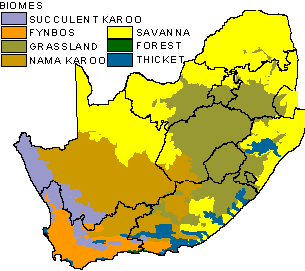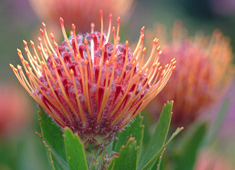Geography and climate
Two oceans & biodiversity
 South Africa has seven major terrestrial biomes, or habitat types -
broad ecological life zones with distinct environmental conditions and related sets of
plant and animal life. (Graphic: Environmental Potential Atlas for South Africa)
Right in the southwest, influenced by swirling cyclonic weather systems
travelling up from the low latitudes, the area around Cape Town is totally anomalous.
It has a Mediterranean climate, with hot, windy summers and cool, moist
winters, creating a unique floral assemblage, known as fynbos locally, but
internationally referred to as the Cape Floral Kingdom.
Although lacking the spectacular array of flowering
plants of the fynbos, the rest
of the country has much to offer too. Afro-montane forests and grasslands grace the
eastern escarpment, and lush coastal forests cloak the rugged Garden Route and
Tsitsikamma coasts.
The semi-desert regions have an incredible amount and variety of succulent
plants - one-third of the world's succulent plant species occur in South Africa - many
of which have a brief but bright flowering season.
And, of course, the lowveld areas are typified by broad-leaved forests which
support a rich game population. Not to be missed in the northern part of the country
is the fabulous baobab tree.
You can enjoy our botanical riches in the many national parks and botanical
reserves or just on the side of the road. The flower season in the Western Cape is
in spring - August and September, when specialist flower-viewing trips are run and
almost every small town has a flower show.
For a really intimate experience with some
big old forest trees, try the tree-top
canopy trail in Tsitsikamma - one of only three in the world.
So, when you're next in one of our national parks, remember to take note of the
wonderful plants as well as the trees. For more information about our wonderful
flora, check out the National Botanical Institute.
Source: South
African Tourism
South Africa has seven major terrestrial biomes, or habitat types -
broad ecological life zones with distinct environmental conditions and related sets of
plant and animal life. (Graphic: Environmental Potential Atlas for South Africa)
Right in the southwest, influenced by swirling cyclonic weather systems
travelling up from the low latitudes, the area around Cape Town is totally anomalous.
It has a Mediterranean climate, with hot, windy summers and cool, moist
winters, creating a unique floral assemblage, known as fynbos locally, but
internationally referred to as the Cape Floral Kingdom.
Although lacking the spectacular array of flowering
plants of the fynbos, the rest
of the country has much to offer too. Afro-montane forests and grasslands grace the
eastern escarpment, and lush coastal forests cloak the rugged Garden Route and
Tsitsikamma coasts.
The semi-desert regions have an incredible amount and variety of succulent
plants - one-third of the world's succulent plant species occur in South Africa - many
of which have a brief but bright flowering season.
And, of course, the lowveld areas are typified by broad-leaved forests which
support a rich game population. Not to be missed in the northern part of the country
is the fabulous baobab tree.
You can enjoy our botanical riches in the many national parks and botanical
reserves or just on the side of the road. The flower season in the Western Cape is
in spring - August and September, when specialist flower-viewing trips are run and
almost every small town has a flower show.
For a really intimate experience with some
big old forest trees, try the tree-top
canopy trail in Tsitsikamma - one of only three in the world.
So, when you're next in one of our national parks, remember to take note of the
wonderful plants as well as the trees. For more information about our wonderful
flora, check out the National Botanical Institute.
Source: South
African Tourism
Would you like to use this article in your publication or on your website? See: Using SAinfo material
 Proteas at Kirstenbosch Botanical Gardens in Cape Town (Photo: South African Tourism)
Proteas at Kirstenbosch Botanical Gardens in Cape Town (Photo: South African Tourism)


